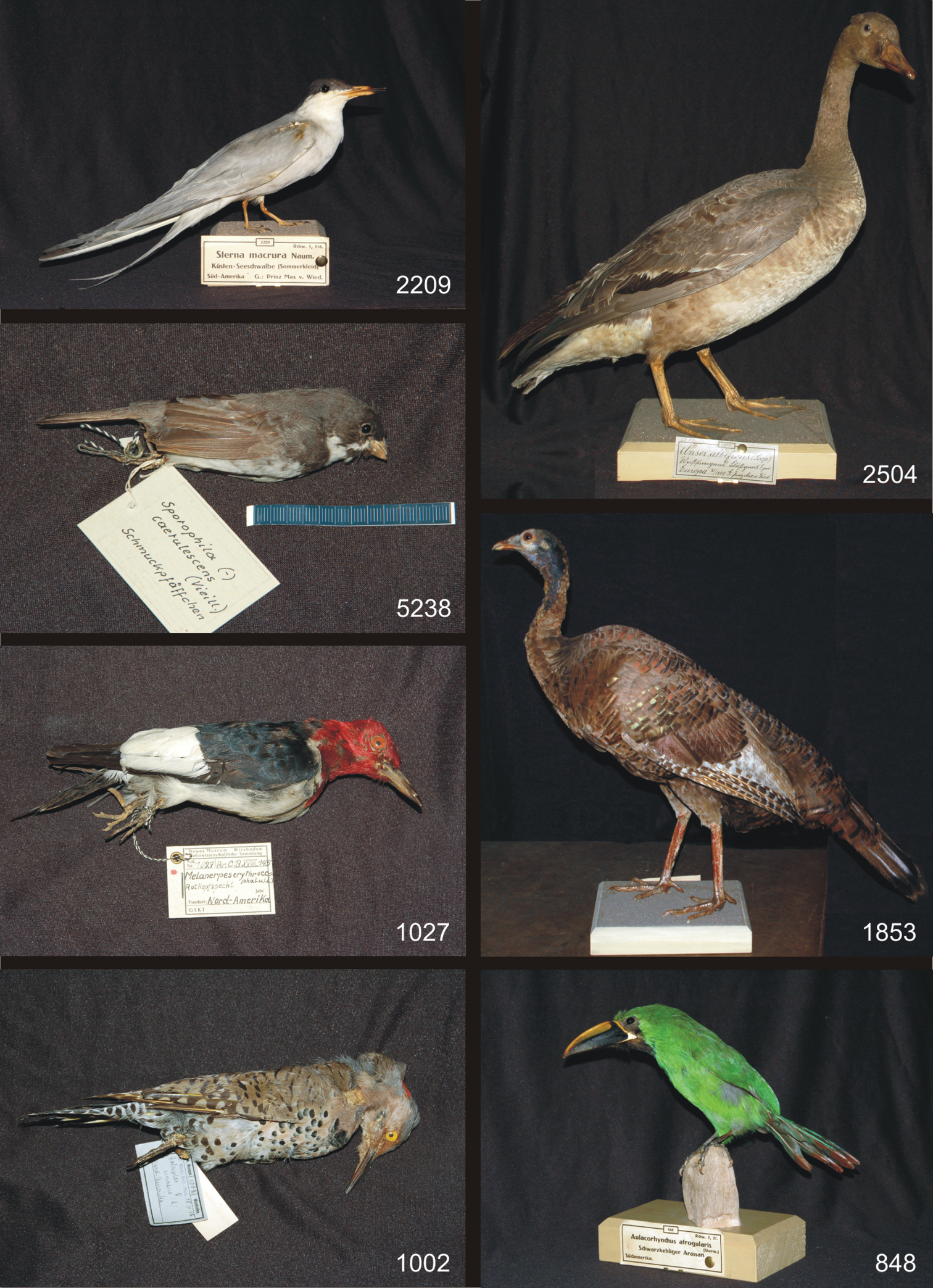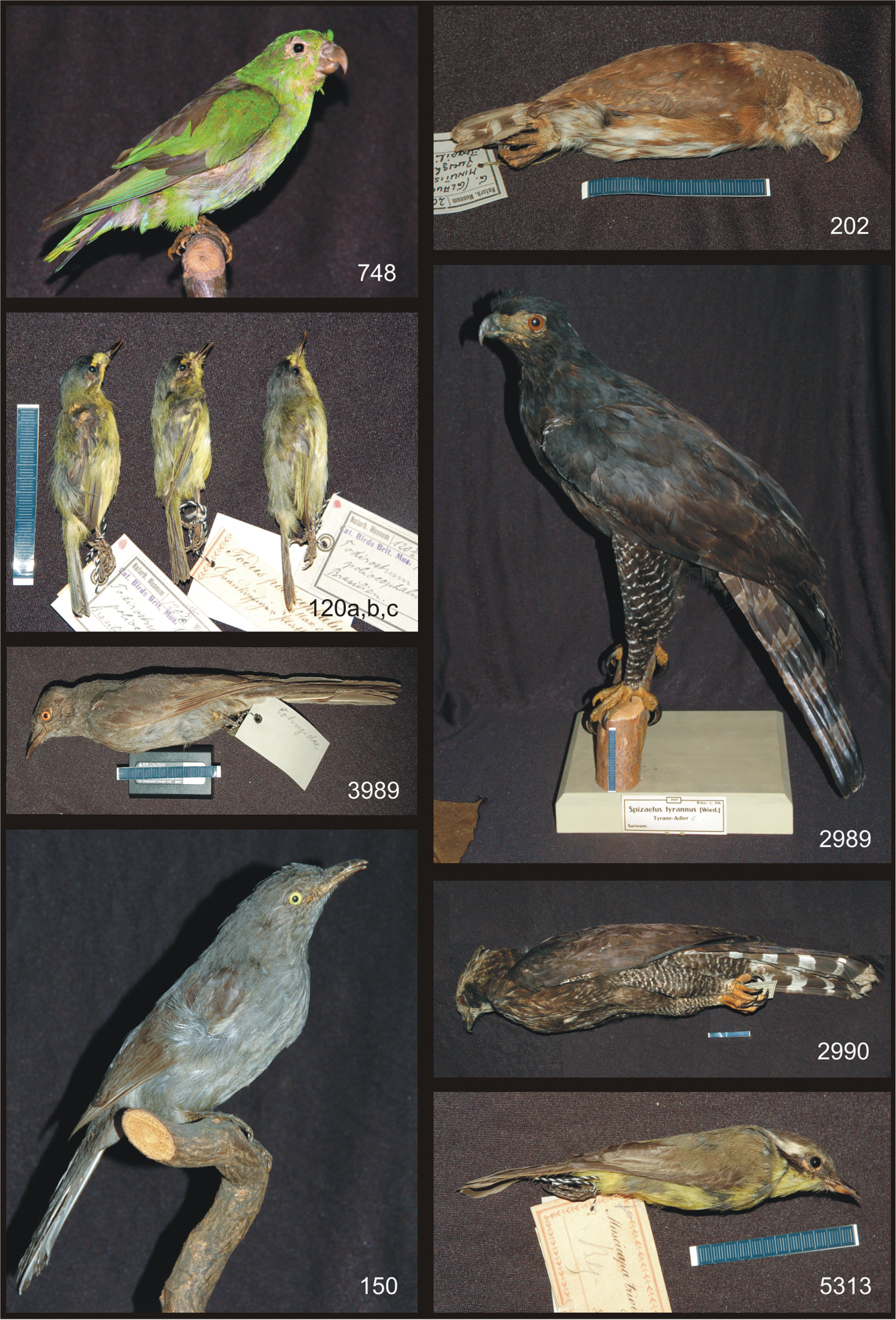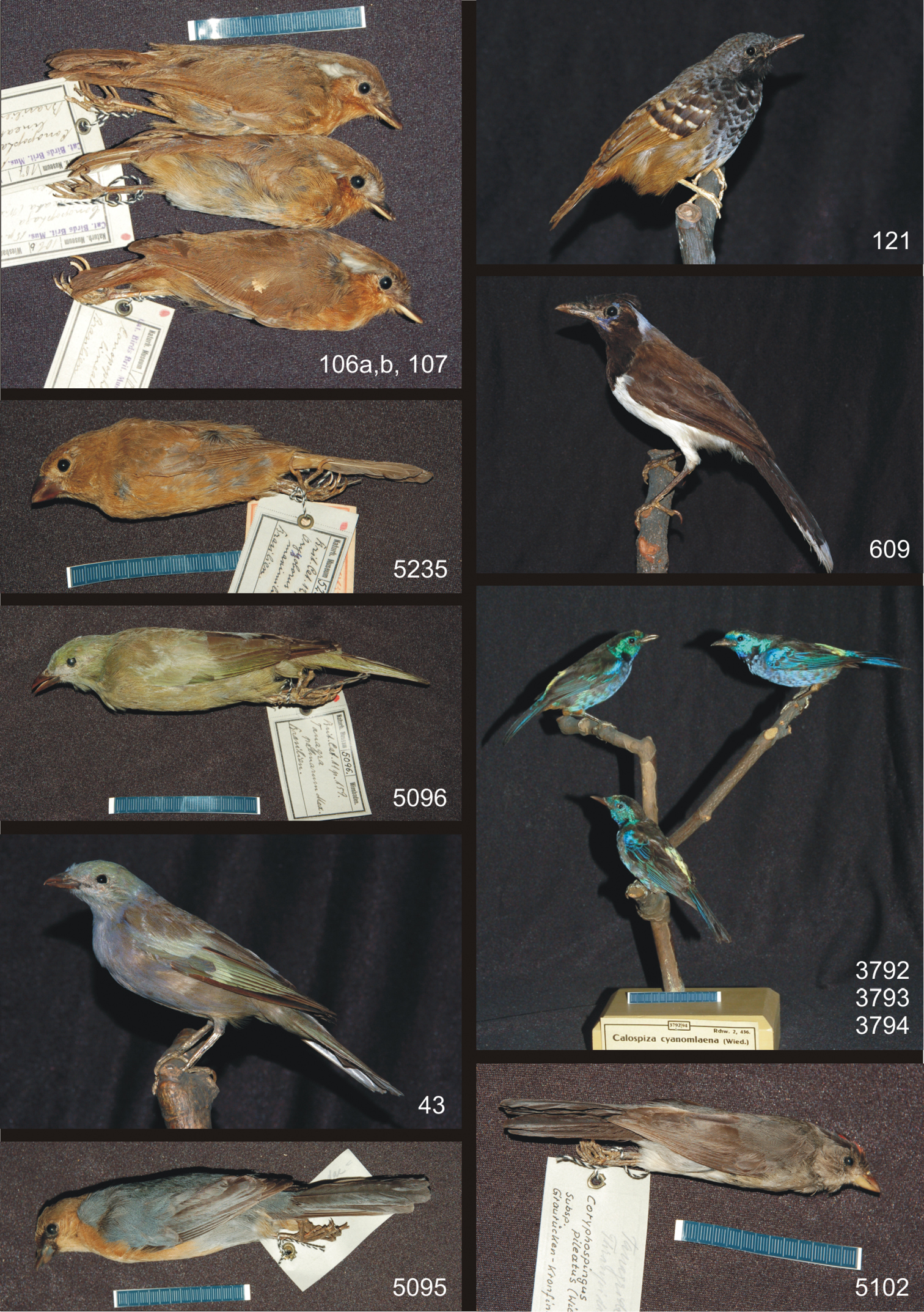






(C) 2013 Dorothee Hoffmann. This is an open access article distributed under the terms of the Creative Commons Attribution License 3.0 (CC-BY), which permits unrestricted use, distribution, and reproduction in any medium, provided the original author and source are credited.
For reference, use of the paginated PDF or printed version of this article is recommended.
Citation: Hoffmann D, Geller-Grimm F (2013) A catalog of bird specimens associated with Prince Maximilian of Wied-Neuwied and potential type material in the natural history collection in Wiesbaden. ZooKeys 353: 81–93. doi: 10.3897/zookeys.353.4198
Bird specimens collected by 19th century explorer and ornithologist Prince Maximilian of Wied-Neuwied form one of the foundation collections of the American Museum of Natural History in New York. However, parts of his collection remained in Germany and came to the Museum Wiesbaden. Since Wied described numerous new species without designating types, some of these specimens might be type material. Here we present a catalog of the 30 Wiesbaden specimens associated with him and discuss their potential type status. We conclude that 17 individuals in 11 species are potential type specimens that should be considered in future taxonomic work.
Aves, types, museum specimens, Brazil, Mata Atlântica
The natural history collection at the Hessian state museum in Wiesbaden (MWNH) owns several specimens that either originate from the collection of Prince Maximilian of Wied-Neuwied or were described by him as new species. In the early 19th century Wied was among the first explorers to travel to Brazil and the especially diverse ecoregion Mata Atlântica, where he collected large numbers of ethnographic objects, plants and animals. In 1870 part of the Wied collection comprising 4, 000 birds, 600 mammals and 2, 000 fish and reptiles was purchased by the American Museum of Natural History in New York (AMNH) and constitutes the cornerstone of its scientific collection (
Besides mammals, reptiles, and amphibians, Wied described 160 species and subspecies of birds. The names of more than 50 of these taxa are still valid today (
Like at the AMNH, in Wiesbaden as well many of the originally mounted specimens were later dismounted and added to the study skin collection. Most of the series of the main Wied collection at the AMNH still bear their original labels, but not every individual specimen has such a label by Wied (see
Wied’s work on birds is significant not only because of the huge number of species and forms described for the first time, but it also gives information on distribution and biology of numerous animals. Even today records on the biology of many organisms are completely lacking. As
In our catalog we follow the systematic classification of the Handbook of the Birds of the World (
Different types of printed labels are indicated as follows:
[*] Label „Naturhist. Museum Wiesbaden.“ or „Naturh. Museum Wiesbaden“, after 1917;
[**] Display label, after [*];
[***] Label „Neues Museum Wiesbaden Naturwissenschaftliche Sammlung“, after 1937.
Bird specimens from Prince Maximilian of Wied-Neuwied in the MWNH collection that are definitely not type material. Clockwise from upper left: Sterna paradisaea, Anser albifrons albifrons, Meleagris gallopavo osceola, Aulacorhynchus prasinus atrogularis, Colaptes auratus auratus-group, Melanerpes erythrocephalus, Sporophila caerulescens.
1. Sterna paradisaea Pontoppidan, 1763 (Charadriiformes – Sternidae)
Arctic Tern – Küstenseeschwalbe
Inv. nr. 2209: 1 ad., breeding plumage, mounted specimen
Labels: a) [*] 2209. Cat. Birds Br. Mus. XXV, 62. Sterna macrura Naum. Südamerika Frühjahr 1846 G.: Prinz Max v. Wied; b) [**] 2209 Rchw. 1, 116. Sterna macrura Naum. Küsten-Seeschwalbe (Sommerkleid) Süd-Amerika G.: Prinz Max v. Wied.
2. Anser albifrons albifrons (Scopoli, 1769) (Anseriformes – Anatidae)
Greater White-fronted Goose – Bläßgans
Inv. nr. 2504: 1 fem. juv., mounted specimen
Labels: a) Anser albifrons, Bechst. Bläßgans ♀ N.Europa; b) [*] 2504. Cat. Birds Brit. Mus. 27 pag. 92. Anser albifrons (Scop.) ♀ N.Europa Novbr. 1847 G.: Prinz Max v. Wied; c) [**] 2504. Anser albifrons (Scop.) Weißstirngans, Bläßgans ♀ juv. Europa XI/1847 G.: Prinz Max v. Wied
3. Meleagris gallopavo osceola Scott, 1890 (Galliformes – Meleagrididae)
Florida Wild Turkey – Florida-Truthuhn
Inv. nr. 1853: 1 fem. ad., mounted specimen
Labels: a) Meleagris Gallopavo Nord-Amerika; b) [*] 1853 Cat. B. Br. Mus. XXII, 389/90 Meleagris americana Bartr. subsp. osceola Scott ♀ Nord-Amerika 1835. G.: Prinz Max v. Wied; c) [**] 1853 Rchw. 1, 304. Meleagris americana Bartr. subsp. osceola Scott Wildes Truthuhn Nord-Amerika S.G.: S. H. Prinz M. v. Wied
4. Aulacorhynchus prasinus atrogularis (Sturm, 1841) (Piciformes – Ramphastidae)
Emerald Toucanet – Laucharassari
Inv. nr. 848: 1 ad., mounted specimen
Labels: a) Pteroglossus atrogularis Gould. Amerika Von Prinz Max erkauft(?) [purchased from Prince Max]; b) [*] 848. Br. C. B. XIX p. 160 Aulacorhamphus atrogularis Sturm S.Amerika S. Prinz Max v. Wied; c) [**] 848 Rchw. 2, 37. Aulacorhynchus atrogularis (Sturm.) Schwarzkehliger Arassari Südamerika.; on pedestal: 1835 ans Museum [to the museum in 1835]
5. Colaptes auratus auratus -group (Linnaeus, 1758) (Piciformes – Picidae)
Yellow-shafted Flicker – Goldspecht
Inv. nr. 1002: 1 fem. ad., study skin
Labels: a) Picus auratus Nord-Amerika; b) [*] 1002 Cat. Birds Brit. Mus. 18.p.12. Colaptes auratus (L.) ♀ Nord-Amerika; catalog: Prinz Max von Wied, 1835
6. Melanerpes erythrocephalus (Linnaeus, 1758) (Piciformes – Picidae)
Red-headed Woodpecker – Rotkopfspecht
Inv. nr. 1027: 1 ad., study skin
Label: [***] Kat.Nr. 1027 Br.C.B. XVIII 145 Melanerpes erythrocephalu (L) Rotkopfspecht Nord-Amerika; database: erworben 1835 von Prinz Max v. Wied [purchased 1835 from Prince Max of Wied]
7. Sporophila caerulescens (Vieillot, 1823) (Passeriformes – Thraupidae)
Double-collared Seedeater – Schmuckpfäffchen
Inv. nr. 5238: 1 male ad., study skin
Label: [***] Kat.Nr. 5238. Sporophila ornata (Licht.) ♂ Brasilien leg. Prinz Max v. Wied; reverse: Sporophila (-)caerulescens (Vieill.) Schmuckpfäffchen
Bird specimens from Prince Maximilian of Wied-Neuwied with potential type status. Clockwise from upper left: Touit melanonota, Glaucidiumminutissimum, Spizaetus tyrannus (mounted), Spizaetus tyrannus (study skin), Conopiastrivirgatus, Lipaugus vociferans (mounted), Lipaugus vociferans (study skin), Todirostrum poliocephalum.
Bird specimens from Prince Maximilian of Wied-Neuwied with potential type status, continued. Clockwise from upper left: Conopophaga lineata, Myrmeciza ruficauda, Cyanocorax cyanopogon, Tangaravelia cyanomelas, Coryphospingus pileatus, Schistochlamys ruficapillus capistratus, Thraupis palmarum palmarum (mounted), Thraupis palmarum palmarum (study skin), Oryzoborus maximiliani.
1. Touit melanonota (Wied, 1820) (Psittaciformes – Psittacidae)
Brown-backed Parrotlet – Braunrückenpapagei
Inv. nr. 748: 1 ad., mounted specimen
Syn.: Psittacus melanonotus Wied, 1820: 275; Urochroma melanota (Stephens, 1826)
Labels: a) Psittacus melanotus Brasilien; b) [*] 748 Br.C.B. XX. p. 352. Urochroma wiedi Allen Brasilien.; c) [**] 748 Rchw. 1, 484. Urochroma melanota (Lcht.) Wied Schwarzrückiger Zwergpapagei Brasilien.; catalog: Prinz Max v. Wied, 1835
Remarks: According to the original description, Wied saw several animals and noted that this new species was displayed at the Berlin museum under the name Psittacus melanonotus.
2. Glaucidium minutissimum (Wied, 1830) (Strigiformes – Strigidae)
Least Pygmy-owl – Kleinstzwergkauz
Inv. nr. 202: 1 ad., study skin
Syn.: Strix minutissima Wied, 1830: 242
Label: [*] 202 Glaucidium (Glaucidium) minutissimum (Wied) Zwergkauz Brasilien
Remarks: According to the original description, Wied examined males and females, but does not give any information about the quantities or the whereabouts.
3. Spizaetus tyrannus (Wied, 1820) (Falconiformes – Accipitridae)
Black Hawk-eagle – Tyrannenadler
I. Inv. nr. 2989: 1 male ad., mounted specimen
II. Inv. nr. 2990: 1 juv., study skin
Syn.: Falco tyrannus Wied, 1820: 360
Labels: I. a) No. 109 Falco Tyrannus Pr. Max Temm. Pl. col. 73. Seite 61 Cuv. Seite 384. Iris gelb.; b) [*] 2989. Brit. Cat. I. 264 Spizaetus tyrannus Wied. ♂ Surinam; c) [**] 2989 Rchw. 1, 386. Spizaetus tyrannus (Wied.) Tyrann-Adler ♂ Surinam.; II. [***] Kat.Nr. 2990 R. I. 386 Spizaetus tyrannus (Wied) Tyrann-Adler Surinam
Remarks: According to the original description, Wied had at least one male at his hands. The AMNH has a specimen (inv. nr. 6381) that
4. Conopias trivirgatus (Wied, 1831) (Passeriformes – Tyrannidae)
Three-striped Flycatcher – Olivbrust-Maskentyrann
Inv. nr. 5313: 1 ad., study skin
Syn.: Muscicapa trivirgata Wied, 1831: 871
Labels: a) Muscicapa trivirgata unserer(?) Beiträge; b) Muscicapa trivirgata M. v. Wied, Brasilien; c) [*] 5313. Cat. Birds Brit. Mus. Conopias (Conopias) trivirgata (Wied) Subsp. Dreistreifentyrann Brasilien
Remarks: According to the original description, Wied examined one female from Bahia.
5. Lipaugus vociferans (Wied, 1820) (Passeriformes – Cotingidae)
Screaming Piha – Tiefland-Graupiha
I. Inv. nr. 150: 1 ad., mounted specimen
II. Inv. nr. 3989: 1 fem. ad., study skin
Syn.: Muscicapa vociferans Wied, 1820: 242
Labels: I. a) [*] 150 Cat. Birds Brit. Mus. 14 p.352. Lathria cinerea (Vieill.) Surinam; b) [**] 150 Rchw. 2, 191. Lipaugus cinereus (Vieill.) Surinam.; II. [*] 3989. R. II. 191. Lipaugus cinereus (Vieill.) Brasilien G.: Geschw. Brambeer.; reverse: Cotingidae
Remarks: In the original description Wied does not state the quantity of examined specimens. According to him, this new species was displayed at the Berlin museum under the name Muscicapa ampelina.
6. Todirostrum poliocephalum (Wied, 1831) (Passeriformes – Tyrannidae)
Grey-headed Tody-flycatcher – Gelbzügel-Todityrann
I. Inv. nr. 120 a: 1 ad., study skin
II. Inv. nr. 120 b: 1 ad., study skin
III. Inv. nr. 120 c: 1 ad., study skin
Syn.: Todus poliocephalus Wied, 1831: 964
Lab els: I. a) Todus poliocephalus, Pr. Max Grauköpfiger Plattschnabel Brasilien; b) [*] 120 3/a Cat. Birds Brit. Mus. 14 p. 71. Todirostrum poliocephalum (Wied) Brasilien.; II. a) Todus poliocephalus Max v. Wied. Grauköpfiger Plattschnabel Brasilien; b) [*] 120 3/b Cat. Birds Brit. Mus. 14. 71 Todirostrum poliocephalum (Wied.) Brasilien; III. a) Todus policephalus, Max v. [abgeschnitten] Grauköpfiger Plattschnabel Brasilien; b) [*] 120 3/c Cat. Birds Brit. Mus. 14 p. 71 Todirostrum poliocephalum (Wied) Brasilien.; reverse of b) (all): Tyrannidae
Remarks: In the original description Wied examined males and females, but did not note the quantities and whereabouts.
7. Conopophaga lineata (Wied, 1831) (Passeriformes – Conopophagidae)
Rufous Gnateater – Rotkehl-Mückenfresser
I. Inv. nr. 106 a: 1 ad., study skin
II. Inv. nr. 106 b: 1 ad., study skin
III. Inv. nr. 107: 1 ad., study skin
Syn.: Myiagrus lineatus Wied, 1831: 1046
Labels: I. [*] 106a. Cat. Birds Brit. Mus. 15. p. 333 Conopophaga lineata (Wied) Brasilien; II. [*] 106b. Cat. Birds Brit. Mus. 15 p. 333. Conopophaga lineata (Wied.) Brasilien; III. [*] 107 Cat. Birds Brit. Mus. 15 p. 333. Conopophaga lineata (Wied.) Brasilien
Remarks: In the original description Wied mentions only one individual. The AMNH has one female holotype (Nr. 6777) listed by
8. Myrmeciza ruficauda (Wied, 1831) (Passeriformes – Thamnophilidae)
Scalloped Antbird – Nördlicher Schuppenameisenvogel
Inv. nr. 121: 1 ad., mounted specimen
Syn.: Myiothera ruficauda Wied, 1831: 1060
Labels: a) Formicivora loricata ♀ Swains. Bahia; b) Formicivora ♂. Bahia. 3. Gust. Schneider, Basel.; c) [*] 121. Cat. Birds Brit. Mus. 15 p. 281. Myrmeciza ruficauda Wied Bahia S.: G. Schneider, Basel.; d) [**] 121 Rchw. 2, 231. Myrmeciza ruficauda Wied. Bahia.
Remarks: In the original description Wied examined males and females, but does not specify the quantities and whereabouts. There are four syntypes at the AMNH: males nr. 5388 and 6829, juvenile male nr. 5386 and female nr. 5385 (
9. Cyanocorax cyanopogon (Wied, 1821) (Passeriformes – Corvidae)
White-naped Jay – Weißnacken-Blaurabe
Inv. nr. 609: 1 ad., mounted specimen
Syn.: Corvus cyanopogon Wied, 1821: 137
Labels: a) Corvus cyanopogon Brasilien; later altered: Cyanocorax Corvus cyanopogon (Max Neuwied) III, 123.; b) [*] 609 Br. C. B. III p. 123 Cyanocorax cyanopogon (Neuwied) Brasilien.
Remarks: In the original description Wied had several individuals at hand.
10. Tangara velia cyanomelas Wied, 1830 (Passeriformes – Thraupidae)
Silvery-breasted Tanager – Rotbauchtangare; group of 3 individuals
I. Inv. nr. 3792: 1 male ad., mounted specimen
II. Inv. nr. 3793: 1 fem. ad., mounted specimen
III. Inv. nr. 3794: 1 fem. ad., mounted specimen
Syn.: Tangara cyanomelas Wied, 1830: 453
Labels: a) Tanagrella velia ♂♀? Gmel Bahia; b) [*] 3792/94 Brit.Cat.11 p. 88. Tanagrella cyanomelaena (Wied.) ♂♀♀ Bahia; c) [**] 3792/94 Rchw. 2, 436. Calospiza cyanomlaena (Wied.) 1 ♂, 2 ♀ Bahia, Brasilien.
Remarks: In the original description Wied mentions several males, while the female was unknown to him. According to
11. Coryphospingus pileatus (Wied, 1821) (Passeriformes – Thraupidae)
Pileated Finch – Graurückenkronfink
Inv. nr. 5102: 1 male ad., study skin
Syn.: Fringilla pileata Wied, 1821: 160
Label:[*] 5102. Cat. Birds Brit. Mus. Tanagra cristatella Spix. ♂ Brasilien; reverse: Tanagridae = Thraupidae Coryphospingus pileatus (Wied) Subsp. Graurücken-Kronfink
Remarks: In the original description Wied described the male without giving details on quantity or whereabouts of the specimens. According to
12. Schistochlamys ruficapillus capistratus (Wied, 1821) (Passeriformes – Thraupidae)
Cinnamon Tanager – Gimpeltangare
Inv. nr. 5095: 1 ad., study skin
Syn.: Tanagra capistrata Wied, 1821: 179
Label: [*] 5095. Brit.Cat.11 p. 301. Schistochlamys capistratus (Max) Brasilien.; reverse: Tanagridae = Thraupidae
Remarks: In the original description, and also in 1831 (p. 500), Wied examined males and females, but did not note specifics on quantities and whereabouts. According to
13. Thraupis palmarum palmarum (Wied, 1821) (Passeriformes – Thraupidae)
Palm Tanager – Palmentangare
I. Inv. nr. 43: 1 ad., mounted specimen
II. Inv. nr. 5096: 1 ad., study skin
Syn.: Tanagra palmarum Wied, 1821: 76
Labels: I. a) Tanagra palmarum Mexiko; b) [*] 43 Brit.Cat. 11 p. 159. Tanagra palmarum Max. Brasilien. Mexiko auf alt/Schauetik.; c) [**] 43 Rchw. 2, 435. Tanagra palmarum Max. Brasilien.; II. [*] 5096. Brit.Cat.11 p.159. Tanagra palmarum Max. Brasilien.
Remarks: In the original description Wied refers to both sexes, but does not specify the quantity and whereabouts of the examined specimens.
14. Oryzoborus maximiliani Cabanis, 1851 (Passeriformes – Thraupidae)
Great-billed Seed-finch – Dickschnabel-Reisknacker
Inv. nr. 5235: 1 fem. ad., study skin
Syn.: Oryzoborus crassirostris Wied, 1830: 564, preocc. Oryzoborus crassirostris (Gmelin, 1789)
Labels: a) Fringilla crassirostris, Max v. Wied Pyrrhula crassirost. ♀ Brasilien; b)[*] 5235. Brit.Cat.12 p. 78 Oryzoborus maximiliani Cab. ♀ Brasilien.
Remarks: Unfortunately we could not obtain the original description.
In conclusion, it can be assumed that 17 individuals in 11 species of birds in the Wiesbaden collection are potential type specimens that should be considered in future taxonomic work. Close examination, comparison with other material, or even genetic tests will be necessary to make a final decision on the specimens’ type status.
We gratefully acknowledge Mary LeCroy (AMNH, New York) for information about the AMNH types, valuable references and extensive comments on an earlier draft of the manuscript. We are also indebted to Sylvain Hodvina (MWNH, Wiesbaden) for help with deciphering of old labels. Morton Isler (Smithsonian Institution, Washington) and Roger Lederer (Ornithology.com) kindly provided expertise on tanager morphology, and Malte Seehausen (MWNH, Wiesbaden) gave additional taxonomic advice. Two anonymous referees commented on an earlier version of the manuscript.


